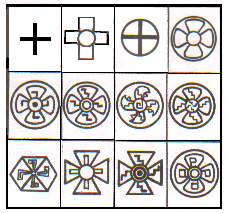|
We have
seen in Chapter 2, Diversification of Languages, how
the people speaking the proto-language diversified and became
the source of a multitude of cultures. In spite of these
changes the original root culture kept its symbols in the form
of an esoteric, semiotic hidden knowledge. These symbols were
representations of monosyllabic root words. Each symbolic sign
can be considered as a being a seal (a
tamga)
conveying a cultural message.
The
Central-Asiatic Uighur who venerated the Sun deity, selected
the + sign to represent their tribal leader. The cross has
been a sacred symbol, adopted worldwide, long before the
Christian era. The word “cross”, which was “kross” in Old
Norse and “crux” in Latin, has its origin in the
proto-language. Kross can be separated into three parts as
Ok-Or-Os. I discussed the meaning of Ok in the previous
chapters. The second syllable stands for venerable, important
and universal. This root word has been pronounced as Oo, Or
and On, depending on the culture. The last suffix “os” means
“us / we” and has transformed into “iz” (Turkish), “is”
(English), “ist” (German) and “est” (French). So, Ok-Or-Os
(Kross) means “we are the venerable (universal) Ok leader”.
The concept of universality has been represented as a circle,
which is the symbol of both the sun and also the whole region,
since the whole surrounding region can be described with a
circular movement of the hand. Below (left) we see how the
cross “Okh” and the circle “On” joined to form new symbols,
pronounced as Onkh, Khno,
Onk and
Ankh.
The same symbols evolved into more artistic and complicated
forms, mostly in Asia, drawn by the Uighur people as seen on
the right hand side.
 
The cross inside a circle does not only mean “we are the
venerable Ok”, but also “we are the ones that worship
the sun” or “the Ok leader has the powers of the Sun
god”. So, the above signs are also telling us that the
people speaking the proto-language worshipped the sun. The sun
cult was the main religion of ancient people and the person
performing spiritual rituals toward the sun during the day and
around a fire during the night was the shaman, the medicine
man and the witch doctor.
 
Above
left we see pictographs from Valcamonica engraved on the south
side of the Alp Mountains. The person extending his/her arms
(left) under the sun is the Okh leader and the one holding a
bow and an arrow (right) is the Ok / Oc / Osc leader. This
pictograph is the typical seal or signature of these people
(in this case the Etruscans) who came to Italy from the north,
(See Chapter 1, The Proto-language of
Central Asia).

On the right side above we see the Onk or Kno found in
different parts of the world; from Cornwall in south-west
England to Peru in South America. In ancient Egypt it became
the Ankh, as the symbol of power and long life. Below we see
different versions of the Onkh.

At first glance one may think that the pictures above do not
represent the same concept. But, in fact they are the semiotic
symbols of a forgotten culture; a culture that spread from
Asia and formed the base of civilization. |
|
References
Geister, Götter und Symbole,
Felix R. Paturi, Frederking & Thaler, 1992, Germany.
ATLAS
Magazine,
January 2000, Shaman Turks, Istanbul, Turkey.
A Journey into China’s Antiquity,
Morning Glory Publishers, 1997, Beijing, China.
Hitit Gunesi,
Sedat Alp, TUBITAK publishing, 2002, Ankara, Turkey
|